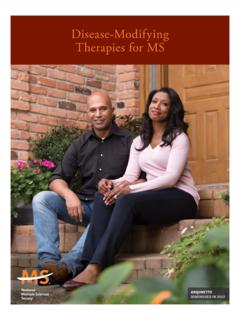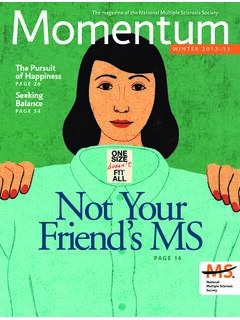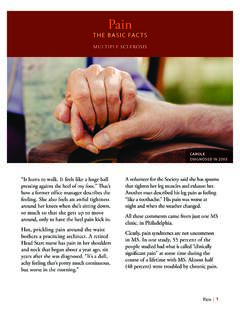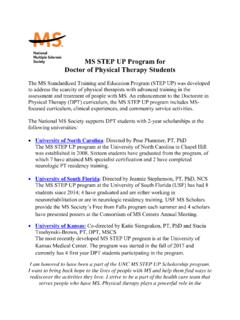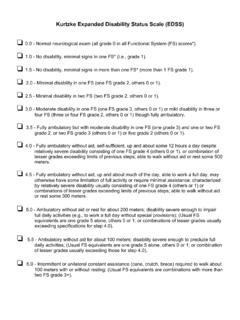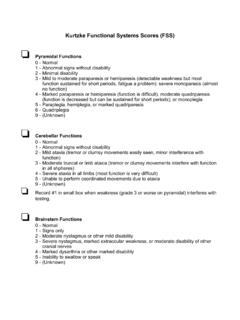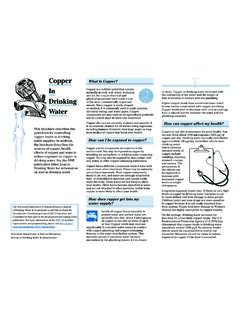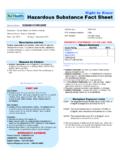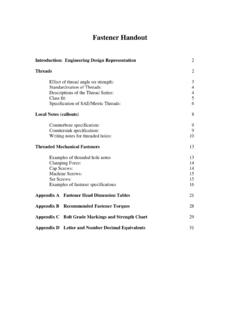Transcription of Gait or Walking Problems - National Multiple …
1 gait or Walking Problems | 1 gait or Walking Problemst h e b a s i c fa c t smu lt iPl e scl erosismany people with ms will experience difficulty with Walking , which is also called ambulation. The term gait refers more specifically to the manner or pattern of Walking (for example unsteady gait ). studies suggest that half the people with relapsing-remitting ms will need some assistance with Walking within 15 years of their Problems in ms are caused by a variety of factors. ms frequently causes fatigue, which can limit Walking endurance. ms damage to nerve pathways may hamper coordination and/or cause weakness, poor balance, numbness, or spasticity (abnormal increase in muscle tone).
2 Visual or cognitive Problems can also interfere with Walking . concerns about falling and appearing impaired in public cause Problems too, sometimes leading to social isolation. gait Problems in ms are all over the map, observes sue Kushner, a physical therapist at slippery rock university in Pennsylvania, with long experience in Multiple sclerosis. This makes Walking Problems difficult to address. Difficult, but not or Walking Problems | 2speak upif you are having difficulty Walking or keeping your balance, if fatigue turns your legs to jelly, don t despair speak up.
3 Many Walking Problems can be significantly improved with physical therapy, exercise, the right assistive device, or medication, including the newly-approved Ampyratm [dalfampridine, see below]. You are not giving in when you seek treatment. untreated Walking Problems can lead to emotional distress, injuries, added fatigue, and suspicion by other people that your abnormal gait stems from alcohol or with your primary healthcare provider about getting an accurate assessment of your gait pattern is an important step toward maintaining and enhancing your healthcare provider will probably refer you to a physical therapist (Pt) for this assessment.
4 In order to analyze the bio-mechanics of your gait , a Pt may ask you to walk across a room or down a hallway in order to observe coordination, positioning of feet, posture, and momentum. You may be asked to provide your medical history. You may also be asked to perform tests that measure muscle strength, fatigue levels, range of motion, spasticity, and balance. some Pts use video cameras to record their observations. computerized devices such as a matt or a platform with sensors can also be used to quantify gait and balance. The good news is that gait evaluation is not painful or invasive.
5 Ampyra ampyra (dalfampridine, formerly called fampridine sR) was approved by the food and Drug administration (fDa) in January 2010 to improve Walking in people with Ms. this oral medication contains a sustained-release formula of 4 -aminopyridine, which blocks tiny pores (or potassium channels) on the surface of nerve fibers. blocking potassium channels may improve the conduction of nerve signals in nerve fibers whose insulating myelin coating has been damaged by Ms. in the clinical trials of ampyra, a significantly greater proportion of people on treatment had a consistent improvement in Walking speed compared to those who took placebo.
6 And those who experienced increased Walking speed also demonstrated improvement in leg strength. ampyra can be used by people with all forms of Ms, along with whatever disease-modifying therapy they are taking. this medication should not be used by anyone with a history of seizures or moderate to severe renal disease. for additional information, contact the ampyra support line at or Walking Problems | 3once the factors involved in your particular gait Problems are identified, you, your Pt and your healthcare provider will work together on a plan of insurance may have tight limits on reimbursement for Pt.
7 Review your coverage to avoid nasty surprises. Your physician and the National ms society may be able to help you battle for the coverage required to address your Problems . or you may need to pay physical therapy costs yourself. it is wise to be frank and upfront with your Pt about cost, payment plans, and the benefits you can expect from weakness clearly interferes with Walking . Damage to neurons (nerve cells) can affect a particular muscle group or groups so they no longer respond to the nervous system input that normally guides the act of Walking . The result may be legs that tire quickly or feel drop is a specific kind of weakness that results from poor nerve conduction to the muscles used to flex the ankle.
8 A person with foot drop finds it difficult to lift one or both feet fully while Walking , making it difficult to manage curbs, stairs, and uneven surfaces. The right assistive device is often the most effective strategy. A brace called an ankle-foot orthotic (AFo) is often prescribed. AFos are lightweight and designed to be hidden by socks or pant new devices the WalkAide and Ness l300 are now available to assist in the management of foot drop. They work by sending low-level electrical impulses to the peroneal (sometimes called fibular) nerve, which signals leg muscles to lift the foot.
9 Although many users find these devices easier to wear and more convenient than AFos, not everyone with ms experiences positive results with them. For the devices to work, the peroneal nerve must be capable of sending a signal and the muscles must be capable of receiving it. in ms, a variety of complications may prevent this from happening. You should be evaluated by a Pt to determine if the WalkAide or Ness l300 would work for devices are also a great deal more expensive than AFos about $5,000-$6,000 and typically not covered by Kushner points out that, muscle weakness in ms isn t the same as the couch-potato syndrome that can be addressed by strength training.
10 In fact, the wrong kind of exercise will do nothing to improve Walking and can lead to fatigue and increased Francois Bethoux of the mellen center for ms treatment and research in cleveland is a strong advocate of exercise for people with ms. However, he cautions most ms patients cannot tolerate the levels of exercise recommended for healthy individuals. intense exercise can cause a temporary increase in ms symptoms. similarly, what is good exercise for one person with ms may not be good for another. experience shows gait or Walking Problems | 4that even a small amount of exercise helps, as long as it is repeated at least 5 days per week.
